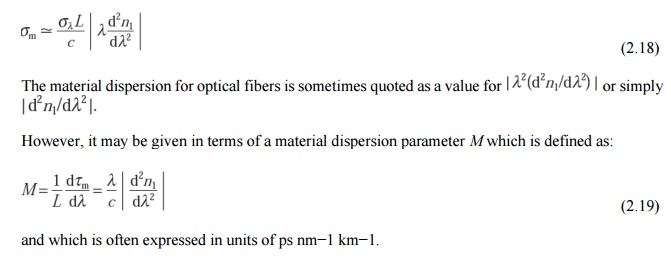Chapter: Optical Communication and Networking : Transmission Characteristics of Optical Fiber
Intramodal Dispersion
Intramodal Dispersion
Chromatic or intramodal dispersion may occur in all types of optical fiber and results from the finite spectral linewidth of the optical source. Since optical sources do not emit just a single frequency but a band of frequencies (in the case of the injection laser corresponding to only a fraction of a percent of the center frequency, whereas for the LED it is likely to be a significant percentage), then there may be propagation delay differences between the different spectral components of the transmitted signal. This causes broadening of each transmitted mode and hence intramodal dispersion. The delay differences may be caused by the dispersive properties of the waveguide material (material dispersion) and also guidance effects within the fiber structure (waveguide dispersion).
1. Material dispersion
Pulse broadening due to material dispersion results from the different group velocities of the various spectral components launched into the fiber from the optical source. It occurs when the phase velocity of a plane wave propagating in the dielectric medium varies nonlinearly with wavelength, and a material is said to exhibit material dispersion when the second differential of the refractive index with respect to wavelength is not zero.
Hence the group delay is given by:

Where n1 is the refractive index of the core material. The pulse delay tm due to material dispersion in a fiber of length L is therefore:

For a source with rms spectral width sl and a mean wavelength l, the rms pulse broadening due to material dispersion sm may be obtained from the expansion of Eq. (2.14) in a
Taylor series about l where:

As the first term in Eq. (2.15) usually dominates, especially for sources operating over the 0.8 to 0.9
μm wavelength range, then:

Hence the pulse spread may be evaluated by considering the dependence of tm on l, where from Eq. (2.14):

Therefore, substituting the expression obtained in Eq. (2.17) into Eq. (2.16), the rms pulse broadening due to material dispersion is given by:

2. Waveguide dispersion
The waveguiding of the fiber may also create chromatic dispersion. This results from the variation in group velocity with wavelength for a particular mode. Considering the ray theory approach, it is equivalent to the angle between the ray and the fiber axis varying with wavelength which subsequently leads to a variation in the transmission times for the rays, and hence dispersion. For a single mode whose propagation constant is β, the fiber exhibits waveguide dispersion when d2β/dl2!=0 . Multimode fibers, where the majority of modes propagate far from cutoff, are almost free of waveguide dispersion and it is generally negligible compared with material dispersion (≈0.1 to 0.2 ns/ km).
However, with single-mode fibers where the effects of the different dispersion mechanisms are not easy to separate, waveguide dispersion may be significant.
Related Topics